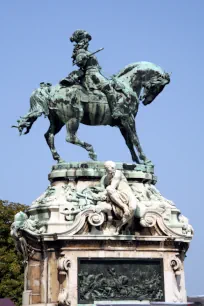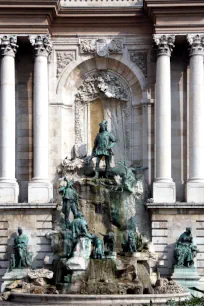The imposing Buda Castle overlooks the city from its elevated position atop Várhegy (Castle Hill), rising forty-eight meters above the Danube. The castle has had a tumultuous history that reflects the ups and downs of Hungary’s fortunes.

Today the castle, often referred to as the Royal Palace (Budavári palota), is home to a number of cultural institutions, including two museums: the National Gallery and the Budapest History Museum.
History
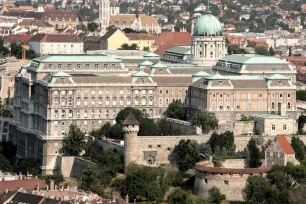
A first castle was built in the thirteenth century after Mongol tribes had invaded Hungary. King Béla IV built a keep surrounded by thick walls in 1243. No trace of this castle remains, and historians aren’t even sure of its precise locations.
The 14th century: Early Grandeur
The foundations of today’s castle, which would later be besieged no less than thirty-one times, were laid in the fourteenth century when King Lajos the Great built a castle in Romanesque style, which was completed in 1356. Some forty years later, during the reign of Sigismund of Luxembourg, this early castle was replaced by a Gothic-style palace. It was one of the grandest palaces in Europe, with an impressive, large Knights’ Hall.
The 15th century: The Kingdom at its Peak
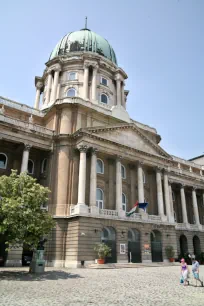
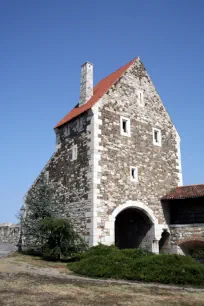
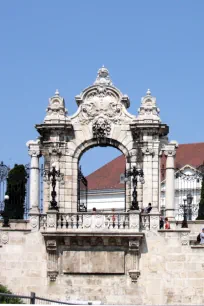
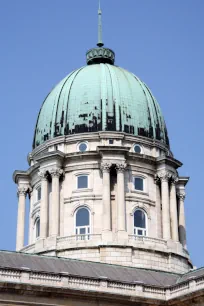
Fifty years later, the great Hungarian King Matthias Corvinus thought the palace built by Sigismund was too sober and small, so he ordered the construction of a new palace in Renaissance style. A palace garden was also created during Matthias’ reign, which marked a high point in Budapest’s history. Artists and craftsmen from across the continent were lured by the city’s prosperity.
The 18th century: The Habsburgs’ Palace
Nothing remains of the early splendor of the Buda Castle. When Budapest was recaptured after the Turkish ruled the city between 1541 and 1686, the complex was completely in ruins.
Hungary’s new rulers, the Habsburgs, built a new, smaller palace between 1714 and 1723. It was designed in a Baroque style by Fortunato de Prati, and construction was supervised by Johann Hölbling. The palace was extended by Empress Maria Theresa, but the great fire of 1810 and in 1849 the (failed) attack of the castle during the Hungarian revolt against the Habsburgs destroyed much of the new palace.
Dual Monarchy Expansion
After the Austro-Hungarian Compromise of 1867, there was a new need for a palace in Budapest to express Hungary’s larger independence. The Habsburg palace was rebuilt and expanded by Miklós Ybl, one of Hungary’s greatest architects. He was aided by Alajos Hauszmann, who was responsible for much of the interior and the impressive Baroque dome. The reconstruction of the palace was mostly symbolic, since no monarch had lived here since 1541.
World War II and another Reconstruction
The palatial complex was still inhabited though, and until 1944 it was the residence of Miklós Horthy, regent of Hungary. Shortly after he was deposed by the Germans, the castle was ruined once again during a drawn-out battle between the Wehrmacht and the Red Army.
Reconstruction of the castle started in 1950 following a design by architect István Janáki, based on Ybl’s plans. The original Baroque dome was replaced with a classicist version. During the reconstruction, the ruins of the fifteenth-century palace were discovered and integrated into the new complex.
The Buda Castle today
The main structure of the Buda Castle, known as the Royal Palace, is rather austere compared to its predecessors; the interior in particular is completely devoid of ornamentation and none of the magnificent royal apartments have been reconstructed (note: plans are in place to renovate the apartments back to their original splendor). But despite its lack of authenticity, the Buda Castle is still an imposing complex, and its more than three-hundred-meter-long (1000 feet) facade facing the Danube is particularly impressive.
The palace consists of a number of wings (named after the letters A to F) arranged around the Lion Courtyard. The courtyard is bordered by the National Library and two museums, the National Gallery and the Budapest History Museum. There’s plenty more to see around the palace, such as several statues and fountains. Below, an overview of the most important sights and attractions in and around Buda Castle.
Habsburg Steps
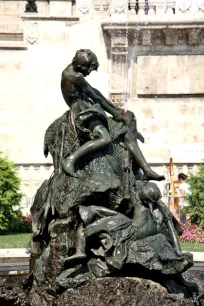
Most visitors enter Buda Castle from St. George Square to the north, where the Sikló funicular connects Castle Hill with the Chain Bridge and Pest. An ornamental gate from the early twentieth century separates the square from the former royal domain and palace.
Right near the gate is a bronze statue of a large bird perched atop a tall pedestal. It is the mythical Turul bird of death, a symbol of the Kingdom of Hungary.
Pass through the gate and walk down the so-called Habsburg steps towards a small terrace decorated with the beautiful romantic fountain of the Fishing Children. The fountain was created in 1912 by Károly Senyey and shows children grasping a huge fish.
Statue of Prince Eugene of Savoy
Walk further south, and you arrive at another, larger terrace with two flower beds and an impressive statue of prince Eugene of Savoy. From here you have a beautiful view over Pest. The statue, created by József Róna and inaugurated in 1900, honors the man who was responsible for defeating the Ottoman Army and liberating Budapest from the Turks. The pedestal is richly decorated with statues of Turkish prisoners and bas-reliefs depicting scenes from the crucial Battle of Zenta (1697).
Hungarian National Gallery
The statue stands in front of the main entrance of the Hungarian National Gallery. This museum occupies four wings (A to D) of the palace, where it displays a comprehensive collection of Hungarian artwork from the Middle Ages to the present day.
Highlights include its collection of fourteenth- and fifteenth-century altarpieces, exhibited in the former throne room. The museum also has a fine collection of Romanticist paintings, including works from Mihály Munkácsy, a Hungarian artist known for his large canvases.
Matthias Fountain
At the other side of the complex, just west of the main dome, is another terrace with four flower beds and a central statue known as the Lószelidítő or Horse Wrangler. It shows a horse tamer holding a restive horse.
Most visitors have little eye for the statue, but instead are drawn to the fountain that flanks one of the wings of the Buda Castle. This is the Matthias Fountain (Mátyás kút), probably Budapest’s most famous fountain. It was designed in 1904 by Alajos Stróbl and depicts a scene from the legend of King Matthias and the beautiful peasant girl Ilonka.
Lions’ Gate & Courtyard
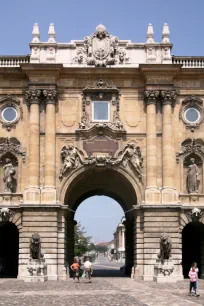
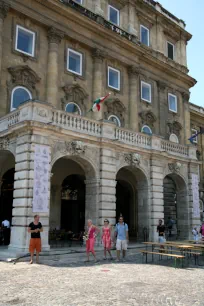
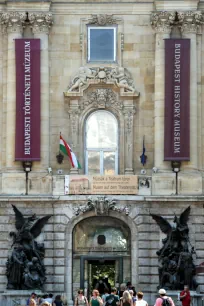
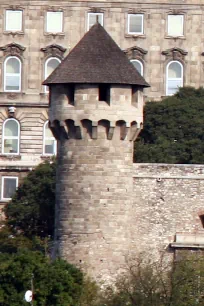
Steps away from the Matthias Fountain, the Lions’ Gate gives entrance to the Lions’ Courtyard (Oroszlános udvarba), the central courtyard of the Buda Castle. The monumental gate is named after the four lion statues that guard the entrance. They were created in 1901 by the Hungarian sculptor János Fadrusz. The gate is decorated with niches, festoons and allegorical sculptures of the Winged Victory. The Hungarian crest crowns the monument.
The patterned pavement of Lions’ Courtyard shows the location of the medieval palace that once stood here, including the fourteenth-century Stephen’s Tower (István-torony). Foundations of the tower can be seen in the nearby historical museum.
National Széchényi Library
To the west of the courtyard, opposite the National Gallery, is the porticoed entrance to the National Széchényi Library. The library occupies the F wing of the Royal Palace, a late nineteenth century expansion created by Miklós Ybl and Alajos Hauszmann. The library was founded in 1802 by count Ferenc Széchényi, who donated his private book collection, containing more than fifteen thousand books and manuscripts. Today, the library holds a copy of every book published in Hungary.
Budapest History Museum
The most southern wing of the palace is home to the Budapest History Museum (Budapesti Történeti Múzeum), which covers the history of Budapest from prehistory to modern times. The museum gives you the chance to see some remains and reconstructions of the medieval palace, including a Gothic chapel and the Knights’ Hall. You can also see some of the marble sculptures that decorated the palace.
Medieval Remnants
If you walk down the steps outside the Budapest History Museum, you can see a courtyard of the former medieval castle. Some of the walls and foundations of the ramparts are original, while other parts are twentieth-century reconstructions.
Walk further through the so-called wheezy gate (Lihegő-kapu) and you reach the south wall with the slender Mace Tower (Buzogánytorony), originally built in the fourteenth century. You can leave the castle via the Ferdinánd Gate (Ferdinánd-kapu) near the tower.
As you walk towards the Tabán neighborhood, you pass the most southern vestige of the Buda Castle. This round bastion is guarded by a beautiful tower gate, reconstructed in the 1950s. You can reach this bastion by walking the uphill road near the lower station of the castle hill funicular.
- Next: Chain Bridge
- More Sights & Attractions in Budapest

